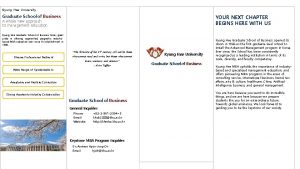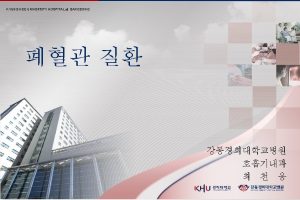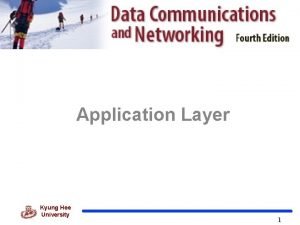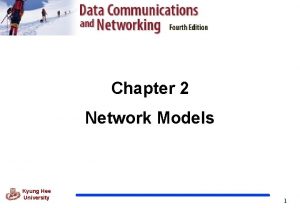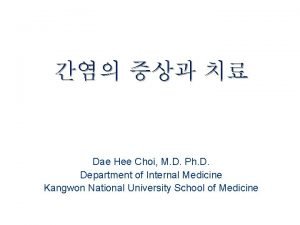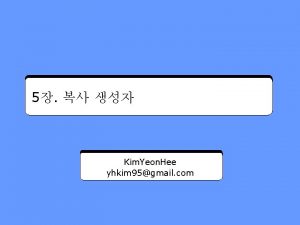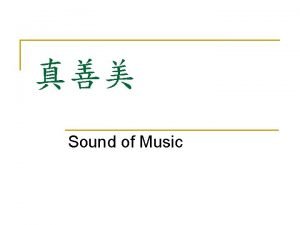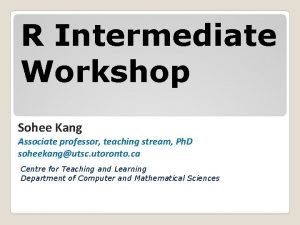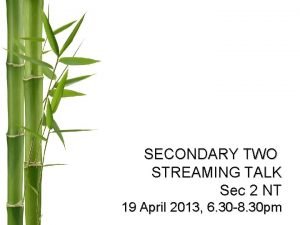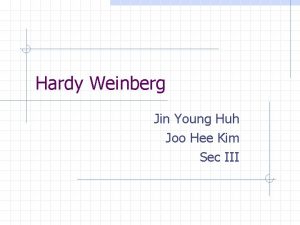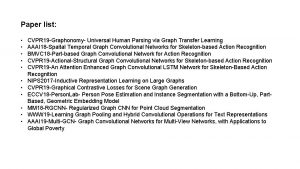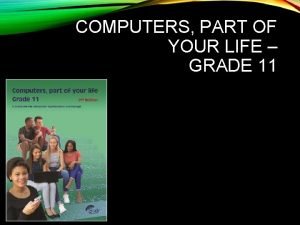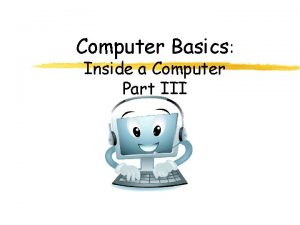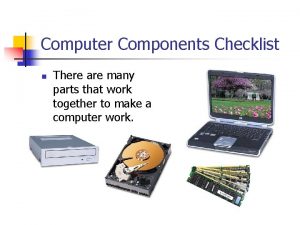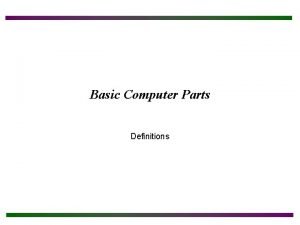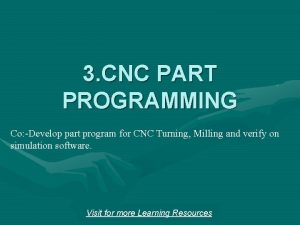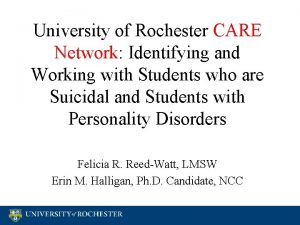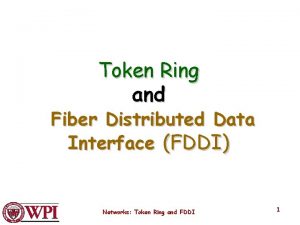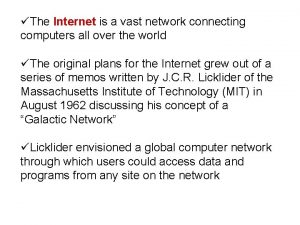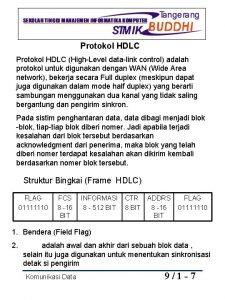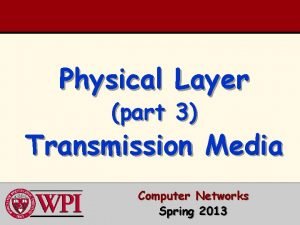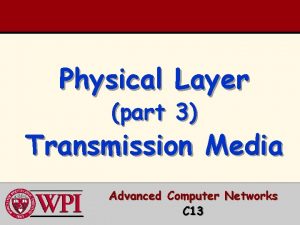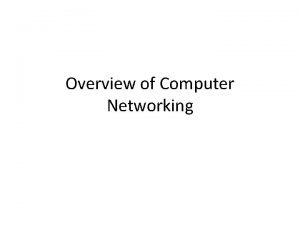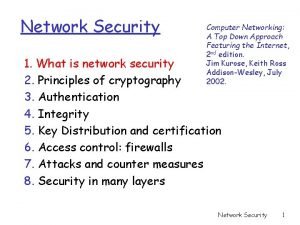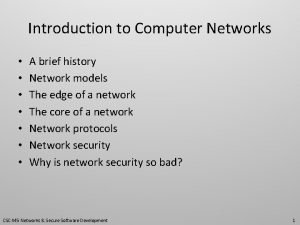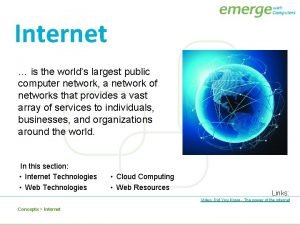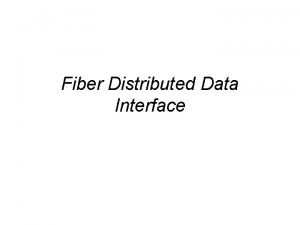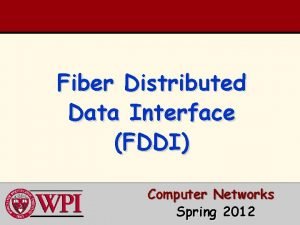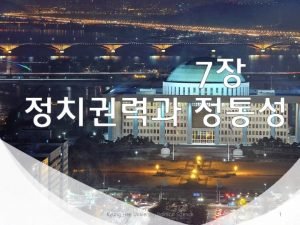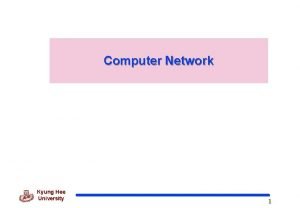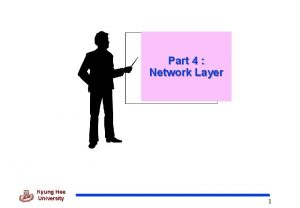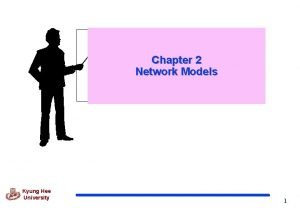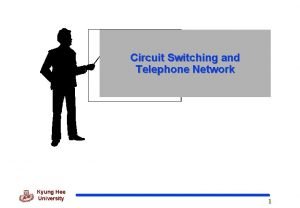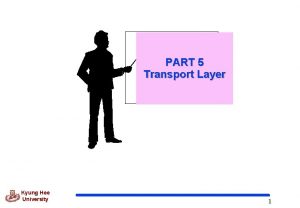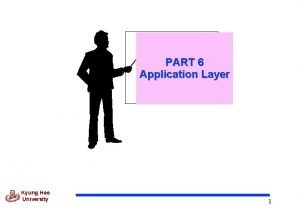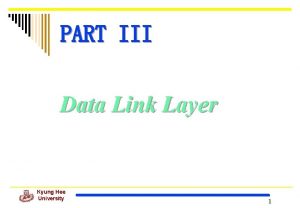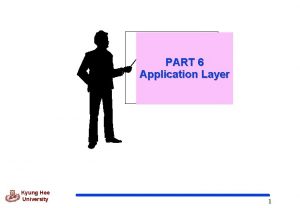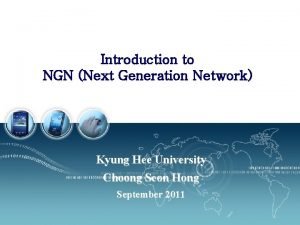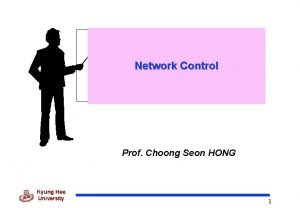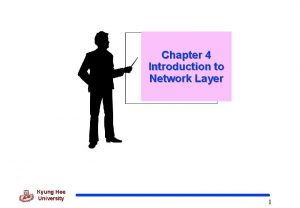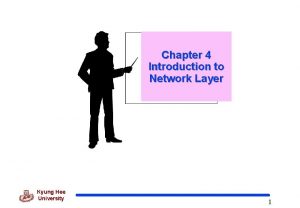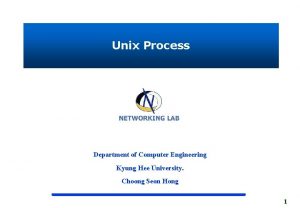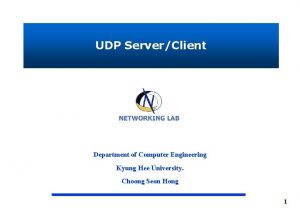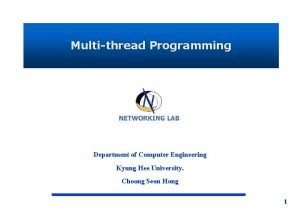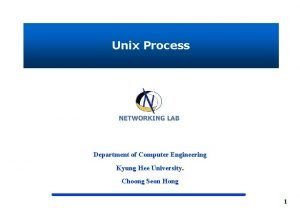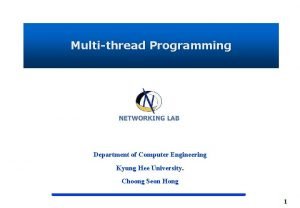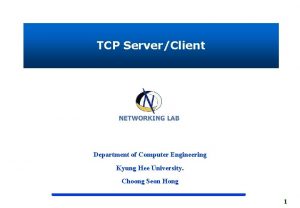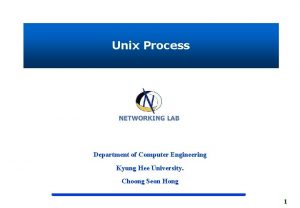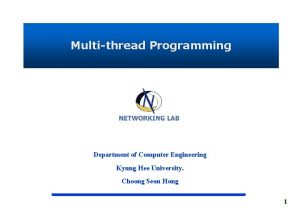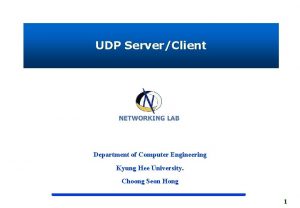Computer Network Kyung Hee University 1 Part 1

























































- Slides: 57

Computer Network Kyung Hee University 1

Part 1 : 데이터 통신과 네트워킹 개요 Kyung Hee University 2

Chapter 1. Introduction (서론) Kyung Hee University 3

1. 1 Data Communications q Data communication is the process of communicating information of binary form between two or more points. q Data communication is the exchange of data (in the form of 0 s and 1 s) between two devices via some form of transmission medium(such as a wire cable) Kyung Hee University 4

Fundamental Characteristics (기본 특성) q The effectiveness of a data communication system depends on three fundamental characteristics 전달(Delivery) ~ must deliver data to the correct destination (the intended device or user) 정확성(Accuracy) ~ must deliver data accurately 적시성(Timeliness) ~ must deliver data in a timely manner Kyung Hee University 5

Data communication system components Kyung Hee University 6

Data communication system components (cont’d) q 메시지(Message) ~ is the information(data) to be communicated. (text, numbers, pictures, sound, video or any combination of these) q 송신자(Sender) ~ is the device that sends the data message. (computer, workstation, telephone handset, video camera) q 수신자(Receiver) ~ is the device that receives the message. (computer, workstation, telephone handset, video camera) Kyung Hee University 7

Data communication system components (cont’d) q 전송매체(Medium) ~ is the physically path by which a message travels from sender to receiver. (twisted pair wire, coaxial cable, fiber- optic cable, laser , or radio waves(terrestrial or satellite microwave)) q 프로토콜(Protocol) ~ is a set of rules that govern data communication. Kyung Hee University 8

Data Presentation q Text q ASCII : by ANSI, 7 bits q Extended ASCII, 8 bits q Unicode : 16 bits q ISO : 32 bits q Numbers : see Appendix B q Images q Audio : continuous q Video Kyung Hee University 9

Direction of Data Flow ~ is used to define the direction of signal flow between two link devices q 단방향(Simplex) is unidirectional, as on a one-way street (keyboard, monitor) q 반이중(Half-Duplex) each station can both transmit and receive, but not at the same time q 전이중(Full-Duplex) both stations can transmit and receive simultaneously Kyung Hee University 10

Direction of Data Flow q Simplex Kyung Hee University 11

Direction of Data Flow q Half-Duplex Kyung Hee University 12

Direction of Data Flow q Full-Duplex Kyung Hee University 13

1. 2 네트워크(Networks) ~ is a set of devices(nodes) connected by media links. q 장치(Device or Node) - computer, printer, any other device capable of sending and/or receiving data generated by other nodes on the network. q 링크(Link) - communication channel Kyung Hee University 14

분산처리(Distributed processing) q In which a task is divided among multiple computers. q Advantage 1. Security/encapsulation - A system designer can limit the kinds of interactions that a given user can have with the entire system. For example, ATM (Automated Teller Machine) 2. Distributed databases - No one system needs to provide storage capacity for the entire database. Kyung Hee University 15

Distributed processing (cont’d) 3. Faster problem solving - Multiple computers working on parts of a problem concurrently can often solve the problem faster than a single machine working alone. 4. Security through redundancy - Multiple computers running the same program at the same time can provide security through redundancy (ex: space shuttle) 5. Collaborative processing - Both multiple computers and multiple users may interact on a task (ex: multiuser network games) Kyung Hee University 16

네트워크 평가기준(Network Criteria) Data communication network criteria Performance Kyung Hee University Reliability Security 17

Performance (성능) q Depends on a number of factors. number of users type of transmission medium(data rate) hardware software : error-free delivery Kyung Hee University 18

Reliability (신뢰성) q Frequency of failure q Recovery time of a network after a failure q Catastrophe Networks must be protected from catastrophic events such as fire, earthquake, or theft. Kyung Hee University 19

보안 (Security) q Unauthorized access q Viruses and Worms Kyung Hee University 20

Physical Structures q Type of Network Connection 점-대-점(Point-to-point) l ~ provides a dedicated link between two devices. 다중 점(Multipoint) : multidrop l ~ is configuration in which more than two specific devices share a single link Kyung Hee University 21

Type of Network Connection q point-to-point Kyung Hee University 22

Type of Network Connection q Multipoint Kyung Hee University 23

Physical Topology q Kyung Hee University 24

Physical Topology q Mesh Every device has a dedicated point-to-point link to every other device. A fully connected mesh network therefore has n(n 1)/2 physical channels to link n devices. Kyung Hee University 25

Physical Topology q Mesh Kyung Hee University 26

Mesh (cont’d) q. Advantages The use of dedicated links guarantees that each connection carry its data load. Mesh topology is robust. Privacy and security. Point-to-point links make fault identification and fault isolation easy. Kyung Hee University 27

그물형 (cont’d) q. Disadvantages ~ are related to the amount of cabling and the number of I/O ports because every device must be connected to every other device, installation and reconfiguration are difficult the sheer bulk of the wiring can be greater than the available space(in walls, ceiling, or floors) can accommodate ®the hardware required to connect each link (I/O port and cable) can be prohibitively expensive Kyung Hee University 28

스타형 (Star : 성형) q. Each device has a dedicated point-to-point link only to a central controller, usually called a hub q 스타형 (Star : 성형) Kyung Hee University 29

Star (cont’d) q. Advantage Each device needs only one link and one I/O port to connect it to any number of others (easy to install and reconfigure) Robustness l if one link fails, only that link is affected Kyung Hee University 30

트리형 (Tree) qis a variation of a star active hub(central hub) ~ contains a repeater, which is a hardware device that generates the received bit patterns before sending them out passive hub ~ provides a simple physical connection between the attached devices Kyung Hee University 31

버스형 (Bus) qis multipoint. One long cable acts as a backbone to link all the devices in the network q. Nodes are connected to the bus cable by drop lines and taps drop line ~ is a connection running between the device and the main cable tap ~ is a connector either splices into the main cable or punctures the sheathing of a cable to create a contact with the metallic core Kyung Hee University 32

Bus 형 Kyung Hee University 33

Bus (cont’d) q. Advantages ~ include ease of installation q. Disadvantages ~ include difficult reconfiguration and fault isolation Kyung Hee University 34

링형 (Ring) q Each device has a dedicated point-to-point line configuration only with the two devices on either side of it q Advantage ~ is relatively easy to install and reconfigure ~ fault isolation is simplified q Disadvantage unidirectional traffic l break in the ring can disable the entire network --> needs dual ring Kyung Hee University 35

네트워크 분류 (Categories of Networks) qthree primary categories 근거리 통신망 (LAN) 도시 통신망 (MAN) 광역 통신망 (WAN) qsize, ownership, distance it cover, physical architecture Kyung Hee University 36

Categories of Networks (cont’d) Network Local area networks (LAN) Kyung Hee University Metropolitan area network (MAN) Wide area network (WAN) 37

Categories of Networks (cont’d) q. LAN(Local Area Networks) ~ is usually privately owned and links the devices in a single office, building or campus Kyung Hee University 38

Categories of Networks (cont’d) Kyung Hee University 39

Categories of Networks (cont’d) q. MAN(Metropolitan Area Networks) ~ is designed to extend over an entire city Kyung Hee University 40

Categories of Networks (cont’d) q. WAN(Wide Area networks) ~ provides long-distance transmission of data, voice, image, and video information over large geographical areas that may comprise a country, a continent, or even the whole world Kyung Hee University 41

Categories of Networks (cont’d) q WAN Kyung Hee University 42

1. 3 Internet q A Brief History Internet (not internet) ARPANET (Advanced Research Projects Agency: ARPA) – mid-1960 s l l Advanced Research Projects Agency (ARPA) in the DOD : presented ideas of ARPANET, 1967 Reality : 1969 (UCLA, UCSB, SRI, U of Utah) Birth of Internet : in 1972 l Vint Cerf and Bob Kahn : Internetting Project TCP/IP : A paper by Cerf and Kahn in 1973 l In 1983, TCP/IP became to official protocol for the ARPANET MILNET : in 1983 CSNET, NSFNET, ANSNET, … Kyung Hee University 43

Internet Today q 1969. Four-node ARPANET established. q 1970. ARPA hosts implement NCP. q 1973. Development of TCP/IP suite begins. q 1977. An internet tested using TCP/IP. q 1978. UNIX distributed to academic sites. q 1983. TCP/IP becomes the official protocol q 1983. MILNET was born. q 1986. NSFNET established. q 1990. ARPANET replaced by NSFNET. q 1991. WWW by CERN q 1995. NSFNET became a research network. q 1995. ISPs started. Kyung Hee University 44

Internet Today Kyung Hee University 45

1. 4 Protocols and Standard q Communication in computer networks ~ occurs between entities in different systems q Entity ~ is anything capable of sending or receiving information q 프로토콜(Protocol) ~ is a set of rules that govern data communication Kyung Hee University 46

Protocol & Standards (cont’d) q Protocol의 주요 요소 문법 (Syntax) ~ refers to the structure or format of the data, meaning the order in which they are presented. 의미론 (Semantics) ~ refers to the meaning of each section of bits. 타이밍 (Timing) ~ refers to two characteristics (when data should be sent and how fast it can be sent) Kyung Hee University 47

Standards q 표준안 (Standards) ~ are essential in creating and maintaining an open and competitive market for equipment manufactures and in guaranteeing national and international interoperability of data and communications technology and processes. Standards De facto (by fact) Kyung Hee University De jure (by law) 48

Standards Organizations (표준화 기구) q Standard Creation Committees ISO (The International Standard Organization) ~ created in 1947 ~ voluntary organization ~ is an organization dedicated to worldwide agreement on international standards in a variety of fields (scientific, technological, economic activity) Kyung Hee University 49

Standards Organizations (cont’d) ITU-T(International Telecommunications Union Telecommunications Standards Sector) ~ is an international standards organization related to the United Nations that develops standards for telecommunications. l Two popular standards developed by ITU-T are the V series (data transmission over phone lines) and the X series (transmission over public digital networks) Kyung Hee University 50

Standards Organizations (cont’d) ANSI (American National Standard Institute) ~ is a nonprofit organization and is the U. S. voting representative to be both the ISO and the ITU-T IEEE (Institute of Electrical and Electronic Engineers) ~ is the largest national professional group involved in developing standards for computing, communication, electrical engineering, and electronics) EIA (Electronic Industries Association) ~ is an association of electronics manufactures in the United States. (EIA-232 -D, EIA-530 standards) Kyung Hee University 51

Standards Organizations (cont’d) q. Forums ~ consist of representatives from corporation that test, evaluate and standardize new technologies. l Frame Relay Forum l ATM Forum and ATM consortium q Regulatory agencies FCC (Federal Communications Commission) MIC (Ministry of Communication) Kyung Hee University 52

Internet Standards q. Internet standard is a thoroughly tested specification that is useful to and adhered by those who work with the Internet q. A specification begins as an Internet draft Working document with no official status and six-month lifetime q. RFC (Request for Comment) Recommendation from Internet authorities Kyung Hee University 53

Standards (cont’d) q by law standard ~ are those that have been legislated by an officially recognized body. q by fact standard ~ are often established originally by manufactures seeking to define the functionality of a new product or technology. proprietary(closed) ~ are those originally invented by a commercial organization as a basis for the operation of its products. nonproprietary(open) ~ are those originally developed by group or committees that have passed them into the public domain. Kyung Hee University 54



 Kyung hee university mba
Kyung hee university mba Kyung hee university hospital at gangdong
Kyung hee university hospital at gangdong Kyung hee university uniform
Kyung hee university uniform Network layer
Network layer Captain kyung
Captain kyung Network topologies
Network topologies Out of programme pause
Out of programme pause Tan hee juan v teh boon kiat case
Tan hee juan v teh boon kiat case Horus portfolio
Horus portfolio Horus hee
Horus hee Fraud section 17
Fraud section 17 Choi dae-hee
Choi dae-hee Yhkim
Yhkim Hee chang trading co., ltd.
Hee chang trading co., ltd. Tan hee juan case
Tan hee juan case Hee joo lee
Hee joo lee Yodelay hee hoo sound of music
Yodelay hee hoo sound of music So-hee kang utsc
So-hee kang utsc Cheong hee kiat
Cheong hee kiat Horus e portfolio
Horus e portfolio Seet tiat hee
Seet tiat hee Joo hee jin
Joo hee jin Part whole model subtraction
Part whole model subtraction Unit ratio definition
Unit ratio definition Part part whole
Part part whole Technical object description example
Technical object description example What are the parts of the bar
What are the parts of the bar The phase of the moon you see depends on ______.
The phase of the moon you see depends on ______. Part to part variation
Part to part variation Cvpr paper list
Cvpr paper list Differences between virtual circuits and datagram networks
Differences between virtual circuits and datagram networks Features of peer to peer network and client server network
Features of peer to peer network and client server network Network systems design using network processors
Network systems design using network processors Network centric computing
Network centric computing Circuit switching vs packet switching
Circuit switching vs packet switching Computer part of your life grade 11
Computer part of your life grade 11 Computer part 3
Computer part 3 External computer parts
External computer parts Computer components
Computer components Basic computer part
Basic computer part Computer aided part programming
Computer aided part programming University of rochester care network
University of rochester care network 沈榮麟
沈榮麟 Error detection and correction in networking
Error detection and correction in networking Fddi ring topology
Fddi ring topology The internet is a vast
The internet is a vast Chordal ring
Chordal ring Fungsi dari high level data link control
Fungsi dari high level data link control Transmission media in computer network
Transmission media in computer network كبيل
كبيل Network computer definition
Network computer definition 5 q
5 q Applications of computer networks
Applications of computer networks History of computer network
History of computer network World's largest computer network
World's largest computer network Character stuffing in computer networks
Character stuffing in computer networks Fddi frame format
Fddi frame format Fddi computer network
Fddi computer network
